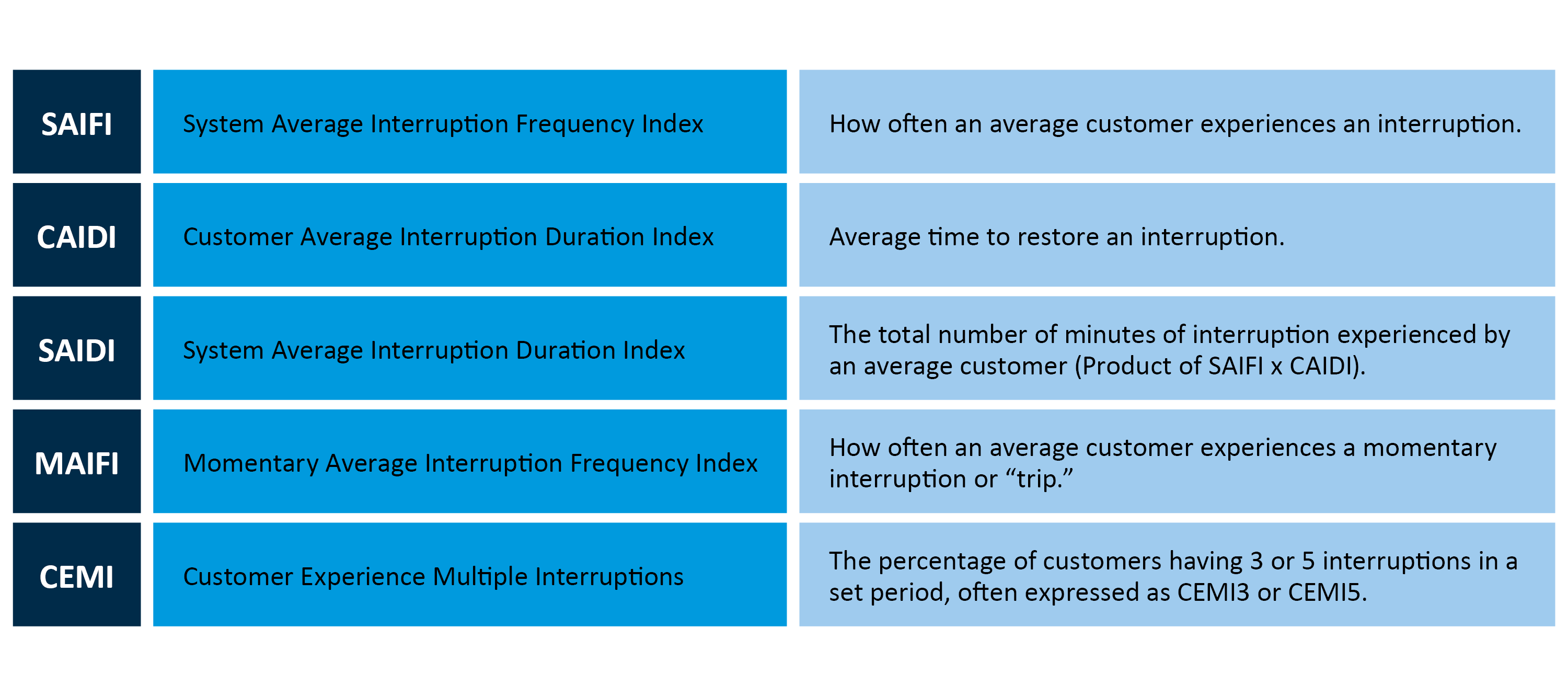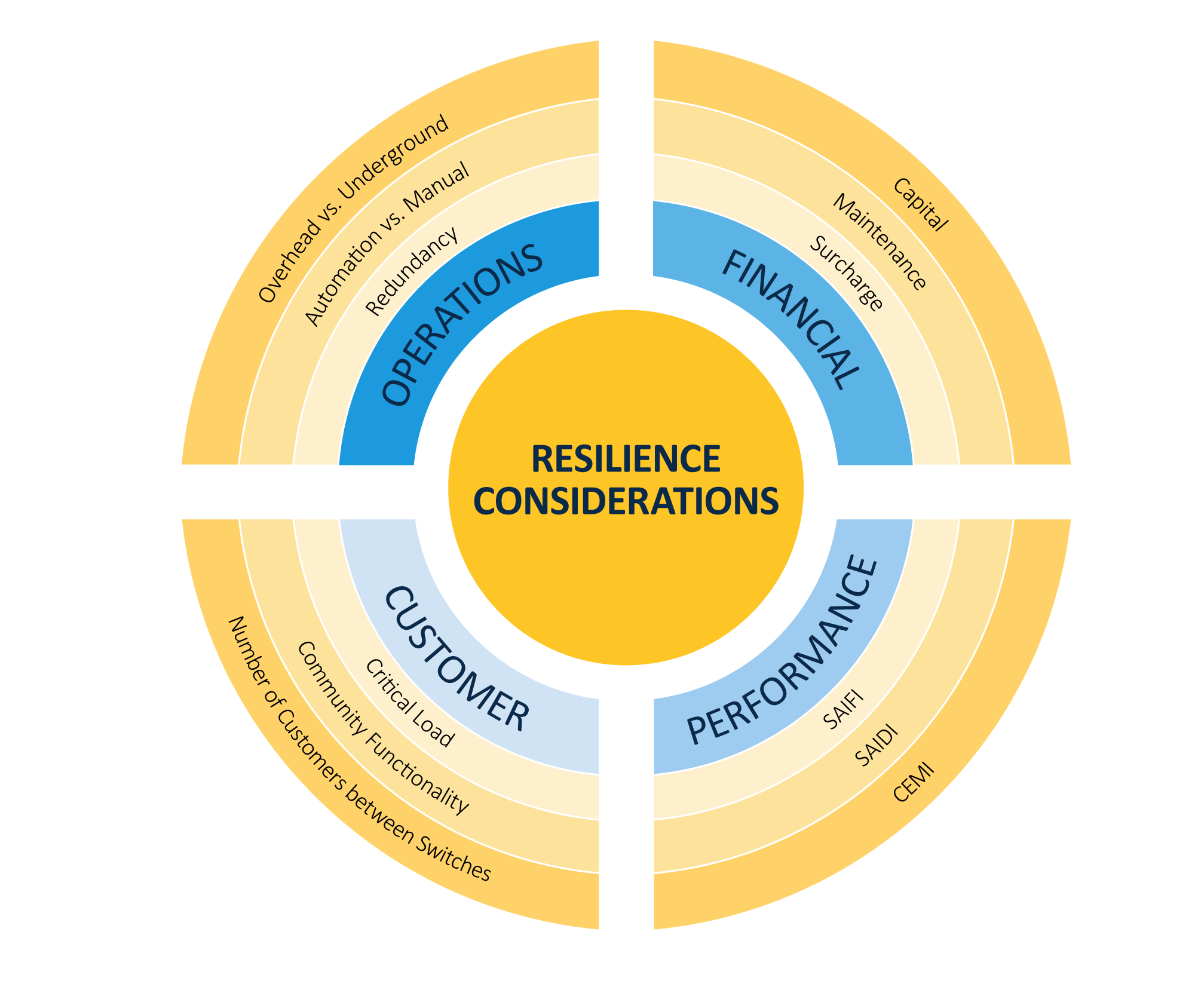Considerations and Criteria for Selecting Electric Distribution Resiliency Projects and Programs
Posted May 18, 2021
The use of data analytics is instrumental in this process. The data that the utilities collect allows the distribution engineer to assess the system's health and determine where areas of weakness are developing. But data alone should not be the sole consideration in project or program selection. Several other considerations based on a knowledge of the system operating and topographical characteristics should be examined.
Base Data Considerations
Every investigation should begin with an assessment of the reliability performance of the distribution system. Utilities today collect a standard set of reliability indices which were developed under the IEEE Guide for Electric Power Reliability Indices (STD 1366). The standard provides utility operators, regulators, and stakeholders consistency and uniformity in distribution reliability measures. There are twelve defined reliability measures in the standard, though the utilities and regulators generally focus on three specific measures: SAIFI, SAIDI, and CAIDI (see Table 1). An experienced engineer involved in analyzing a circuit or section of a feeder's performance will utilize multiple reliability measures to get the full scope of the circuit or segment performance.
Table 1 - Selected Reliability Measure Definitions
 |
Operating and Topographical Considerations
Once the poor performing area is identified, and the reliability measures for that circuit or segment understood, the utility engineer needs to consider the multiple ways to solve a resilience problem. The four core elements for consideration include (see Graph 1):
- Performance
- Financial
- Operating
- Customer
Let’s consider each of these elements briefly.
Performance
SAIFI, CAIDI, and SAIDI offer a high-level assessment of the reliability performance of the circuit or segment. However, alone, they may not be enough. As an example, a generally improving SAIDI may mask either a deteriorating SAIFI (experienced by more frequent outages) or, more likely, longer duration outages (a worsening CAIDI).
A good metric to target a specific poor-performing area is CEMI. While most customers may experience less than one outage a year, a customer or group of customers experiencing three, five, or more outages a year (CEMI3, CEMI5) certainly experiences poor reliability as measured against the norm. Utility engineers are well served using CEMI to focus on those reliability hot spots.
Beyond the reliability performance measures, good asset management data is essential. A strong asset management program will, at a minimum, inform the engineer of the age of the utility plant, detail the condition-based maintenance practices, and provide a good history of the asset’s operating, maintenance and repair frequency for consideration in a replace or repair selection.
Financial
All good utility engineers understand they are stewards of their customers’ funds and will strive to make efficient use of the capital or maintenance funds available to them. Depending on the scope and breadth of the work proposed, the engineer may need to decide if a capital project, such as building a new line, has more value than a maintenance job, such as re-tying a conductor, installing animal guards on transformers, and replacing deteriorated cross-arms.
Another option more frequently available to utilities is the use of distribution improvement surcharges. Suppose several large projects or programs are identified incremental to what is approved in the company’s rate filing. In that case, utilities may have the option to file for expense recovery through a surcharge mechanism. These mechanisms generally allow the utility to true up its incremental spending annually and recover the expenditures sooner, rather than waiting for the next rate case.
Most important for the utility engineer to remember is that financial decisions should always make the most efficient use of the available funds and present a realistic long-term solution to the problem being addressed.
Operations
Once the analytics have been reviewed, understanding the operating and topographical characteristics of the electric distribution system can add insight on the best alternative. Similar to a constructability review, discussions with field staff can provide information to the utility engineer that isn’t apparent in the performance reports.
One consideration is the option to utilize automation versus manual operations for switching. While automation is generally preferred, the utility’s communication network may lack the robustness needed to allow a large quantity of lower priority devices on it. In remote areas, the communication network may be unreliable. Nonetheless, if a robust communications network exists, it is in the remote areas that automation provides real customer value. This allows the utility control room operators to isolate the fault to the smallest possible number of customers, often before a repair truck can be dispatched.
Another consideration is to utilize an underground cable solution versus an overhead wire solution. If there is an “express” circuit with poor performance, it may be better to consider strategically undergrounding a portion of it to enhance its survivability. In lieu of undergrounding, using a robust construction method such as spacer cable and tree wiring are excellent alternatives, especially in heavily treed regions.
To enhance options during an outage and speed up the recovery, the diverse routing of circuit paths and installation of complementary circuits on alternative substation busses provides diversity to an area. It gives operators and engineers alternatives to secure a quick and efficient restoration.
Customer
The most important consideration is the impact of the engineer’s project or program selection and design on the customer. The engineer should design a project or program that is cost-effective, makes efficient use of available funds, and brings forth the desired level of resilience improvement.
There will always be outages. The objective is to minimize the temporary disruption experienced by the customers. To that end, an engineer is well served to consider the project or program that best ensures a load center’s survivability or enhances the utility’s ability to restore a load center quickly. The maintenance of the core elements of a functioning community (police station, town hall, convenience store, gas station) allows local government to better address the community’s health, safety, and welfare needs, allowing the utility to stay focused on recovery.
In designing projects and programs in areas lacking the desired standard of resiliency, utility engineers should review critical infrastructure lists with local community leaders and understand the elements of the community’s resiliency that are important to them. These may include well pumps, emergency services communication towers, or shelters. Considering how to provide for hardened feeders (underground, spacer cable, tree wire), multiple electrical sources (switching alternatives, path diversity), and limiting the number of customers between switching devices is essential in ensuring the utility has the best chance at restoring service quickly and improving levels of reliability performance.
Graph 1 - Resiliency Considerations
 |
Conclusion
Severe weather is impacting the electric grid more seriously and in ways not experienced in the past. Utilities must adapt not only to the changing environment but also to increasing customer expectations. A core premise of the resiliency spectrum is not only the recovery but adaptation. In this context, once the project or program has been executed, post-reliability measures will help gauge the effectiveness of the solution and facilitate future decision-making.
The use of analytics to make data-driven decisions will help justify the business case to stakeholders and regulators. But other items for consideration are just as important and will lend insight into the performance of the distribution system not readily apparent in the data alone. Being able to tell “the rest of the story” provides the comprehensive and thorough assessment required of the utility.
At CHA, our utility engineers have years of experience across multiple utility customer bases and know how to design projects and programs to elate our customers. CHA’s engineers ask the right questions and look for the client's insight to develop the project and programs that enhance the resiliency of the electric grid. “Responsibly improving the world we live in” is not just a tagline; it is the CHA way.